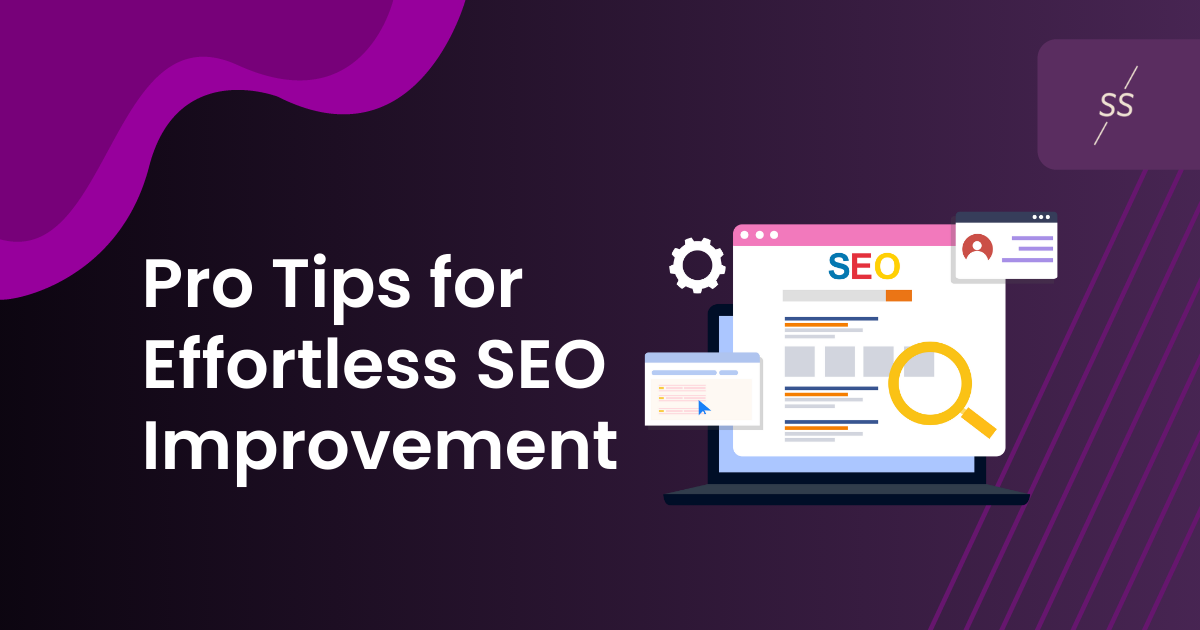Imagine your website, beautifully designed, and full of valuable content, but lost on page 5 of Google. Visitors can’t find you. Your potential customers are heading elsewhere. It’s frustrating to know that while you’re working hard, competitors are taking the spotlight. Without proper visibility, even the best content and products fall short.
By mastering SEO’s foundational elements, you can ensure your website gains the visibility it deserves, driving traffic, engagement, and success. This guide breaks SEO into 9 beginner-friendly steps, making it simple to get started and see results.
What is SEO?
SEO, or Search Engine Optimization, is the art and science of improving your website to make it more visible on search engines like Google. When someone searches for a topic related to your business, SEO helps ensure your website appears in the results.
Search engines analyze factors like keywords, page speed, and user experience to rank websites. By optimizing these elements, you can attract more organic traffic, leading to higher engagement and conversions.
Why is SEO Important for Beginners?
For beginners, SEO is the gateway to success online. Here’s why it’s crucial:
Increased Visibility:
Appearing on the first page of search results significantly boosts your site’s exposure.
Cost-Effective Marketing:
Organic traffic generated by SEO doesn’t require paid advertising.
Credibility and Trust:
Websites that rank higher are perceived as more trustworthy by users.
Without SEO, even the most impressive website can remain invisible to your audience.
9 Key Elements of SEO

1. Keyword Research: Understanding What People Search For
Keyword research is the cornerstone of any SEO strategy. It helps you discover what your audience is searching for, allowing you to customize your content accordingly.
How to Conduct Effective Keyword Research:
- Use tools like Google Keyword Planner or Ubersuggest.
- Identify long-tail keywords that match user intent.
- Focus on high-volume, low-competition keywords for quick wins.
Example: A bakery might target phrases like “best cupcakes in New York” instead of just “cupcakes.”
2. On-Page Optimization: Perfecting Your Website’s Content
On-page optimization involves fine-tuning elements on your website to make it search-engine-friendly.
Key Areas to Optimize:
- Title Tags: Include your main keyword naturally and compellingly.
- Meta Descriptions: Write clear, concise summaries for better click-through rates.
- Headings (H1, H2, etc.): Organize content logically for readers and search engines.
- Internal Links: Link to related content within your site to improve navigation and engagement.
3. Quality Content: Engaging and Informative Content Wins
Search engines prioritize content that solves problems, answers questions, and keeps readers engaged.
Best Practices for Content Creation:
- Write with your audience in mind, not just for search engines.
- Use a conversational tone for better engagement.
- Regularly update old content to keep it relevant.
Incorporating visuals like images, videos, and infographics enhances your content’s appeal and shareability.
4. Mobile-Friendliness: Catering to Modern Users
With over 60% of searches happening on mobile devices, a mobile-friendly website is non-negotiable.
How to Ensure Mobile Optimization:
- Use responsive design that adapts to different screen sizes.
- Optimize images for faster mobile loading.
- Ensure buttons and links are easily clickable on smaller screens.
Google’s Mobile-Friendly Test is a helpful tool for evaluating your site’s performance.
5. Website Speed: Keeping Visitors Engaged
A slow website frustrates users and leads to higher bounce rates. Search engines penalize slow sites, affecting your rankings.
Ways to Improve Page Speed:
- Compress images without sacrificing quality.
- Enable browser caching for returning visitors.
- Use a content delivery network (CDN) for faster global access.
6. Link Building: Establishing Authority Through Connections
Backlinks, or links from other websites to yours, signal trust and authority to search engines.
How to Build High-Quality Backlinks:
- Publish guest posts on industry-relevant blogs.
- Create shareable content like data reports or infographics.
- Reach out to influencers and collaborate on content.
Remember, focus on quality over quantity. A few links from reputable sites can outperform dozens from low-quality sources.
Explore more: Link Building Strategies: The Cornerstone of Off-Page SEO
7. User Experience (UX): Creating a Seamless Journey
A well-designed website keeps visitors engaged and improves conversions.
UX Tips for Better SEO:
- Simplify navigation for easier browsing.
- Use white space strategically to enhance readability.
- Ensure clear calls-to-action (CTAs) that guide users effectively.
Positive user experiences reduce bounce rates and signal search engines that your site is valuable.
8. Analytics and Tracking: Measuring Your Success
Tracking your progress is essential for refining your strategy.
Tools to Monitor SEO Performance:
- Google Analytics: Track traffic, user behavior, and conversions.
- Google Search Console: Identify technical issues and monitor search rankings.
- SEMrush or Ahrefs: Analyze competitor strategies and track keyword performance.
Regularly reviewing these metrics ensures you’re on the right path.
9. Local SEO: Targeting Nearby Customers
If your business serves a specific area, local SEO helps you connect with nearby customers.
Steps to Optimize for Local SEO:
- Create and optimize your Google My Business profile.
- Include local keywords in your content, titles, and meta descriptions.
- Collect positive reviews and respond to customer feedback.
For example, a plumber might use “Emergency plumbing services in Chicago” as a keyword.
Pro Tips for Effortless SEO Improvement

1. Optimize for Voice Search
With the growing use of voice assistants like Siri, Alexa, and Google Assistant, voice search optimization has become essential. People use conversational phrases and questions when searching verbally, which is different from traditional typing.
How to Optimize for Voice Search:
- Use natural language: Incorporate long-tail keywords and question-based phrases like “How do I find a great pizza place nearby?”
- Focus on local queries: Voice searches are often location-based, so optimize your content with geo-specific keywords.
- Provide concise answers: Since voice assistants read out answers, ensure your content answers questions clearly within 40-50 words.
Optimizing for voice search enhances user experience and makes your site more visible for voice-activated queries.
2. Publish Consistently
Search engines reward websites that consistently add fresh content. Regularly updating your website signals to search engines that your site is active and relevant. This keeps your content aligned with the latest trends, user needs, and search queries.
How to Maintain Consistent Publishing:
- Start a blog: Regular blog posts allow you to target new keywords and provide value to your audience.
- Repurpose old content: Update outdated blog posts and turn them into fresh content for SEO gains.
- Create a content calendar: Plan and schedule your posts to ensure you consistently publish new material.
Consistent content publishing keeps your website relevant and helps you stay competitive in search rankings.
3. Secure Your Website
Security is a critical ranking factor for search engines, especially with Google’s preference for HTTPS websites. A secure website ensures user trust, preventing hackers from interfering with your site and data.
Why HTTPS Matters:
- Improves user trust: A padlock icon next to your URL signals a secure site, making visitors feel safe.
- Boosts SEO rankings: Google gives a ranking advantage to HTTPS sites, meaning secure websites have a better chance of appearing higher in search results.
- Protects sensitive data: HTTPS encrypts information shared between users and your website, such as login details and payment information.
Make sure to implement SSL certificates to secure your site and improve both your security and SEO performance.
4. Use Rich Snippets
Rich snippets enhance your search results with additional information, like star ratings, images, or FAQ answers. These eye-catching elements help your listings stand out and can improve click-through rates (CTR).
How to Use Rich Snippets Effectively:
- Add structured data: Use schema markup to help search engines understand your content.
- Include review ratings: Add review stars to products or services, so users can see your reputation at a glance.
- Optimize for FAQs: If you answer common questions, include FAQ markup to make your content eligible for featured snippets.
Rich snippets improve visibility and make your search results more attractive to users, increasing the likelihood of clicks and engagement.
5. Grip on Social Media
Social media plays a crucial role in driving organic traffic to your website. While social signals may not directly impact SEO rankings, they contribute to brand awareness and website visibility.
How to Leverage Social Media for SEO:
- Share blog posts: Regularly share new blog posts, product updates, or announcements to drive traffic from social platforms.
- Engage with your audience: Respond to comments, messages, and shares to increase user engagement and encourage social interaction with your content.
- Use hashtags strategically: Use trending and relevant hashtags to make your posts more discoverable on platforms like Instagram and Twitter.
Engaging on social media helps you grow your audience, increase traffic to your site, and build credibility, all of which indirectly benefit SEO efforts.
FAQs
How Long Does SEO Take to Show Results?
SEO typically takes 3–6 months to show results, depending on competition and strategy. Consistency, quality content, and effective strategies are key to long-term success. Be patient as SEO is a long-term investment.
Is SEO Suitable for Small Businesses?
Yes, SEO helps small businesses compete with larger companies by targeting specific audiences and niches. It’s cost-effective and drives relevant, local traffic. Small businesses can grow with proper SEO techniques.
Do I Need a Professional to Handle SEO?
While DIY SEO is possible, professionals can optimize advanced strategies and save time. They bring expertise and ensure faster, more efficient results. Professionals can also help keep up with ongoing algorithm changes.
Conclusion
SEO is no longer optional in today’s digital landscape—it’s essential. By focusing on these 9 elements, even beginners can improve their website’s performance and attract the right audience. Start small, measure your progress, and build momentum as you gain confidence.
Your journey to better rankings and visibility starts now. Implement these tips and watch your efforts pay off!
Ready to grow your online presence? Start your SEO journey today!
